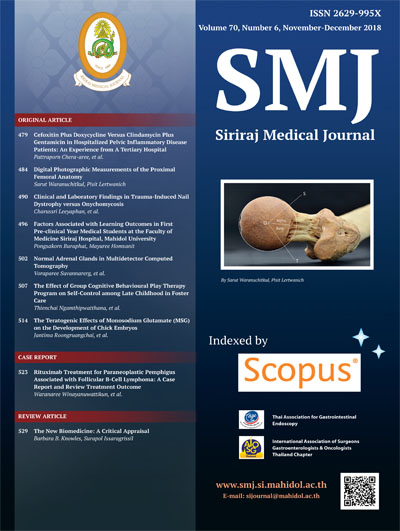Normal Adrenal Glands in Multidetector Computed Tomography
Keywords:
Size; morphology; adrenal gland; multidetector computed tomographyAbstract
Objective: To characterize normal adrenal glands in an adult Thai population using multidetector computed tomography (MDCT).
Methods: We retrospectively reviewed the scans of 175 consecutive patients who underwent renal CT angiography for potential kidney donation with attention to the location, morphology, and enhancement of both adrenal glands. Each reader measured the body and limb thickness in the axial and coronal planes, and the length in the axial plane. The interclass correlation coefficient (ICC) between the two readers was generated. We employed mean, SD, and 95th percentile of normal adrenal gland size by using pooled data of both reviewers.
Results: The 95th percentiles of normal adrenal glands, which might be useful as cutoff values to distinguish between normal and pathological adrenal gland size, were calculated. The right adrenal gland was more often relatively cephalad to the left adrenal (58.9%). The most common morphology of both adrenal glands was the inverted Y, with inverted V and linear shapes less common. Both adrenal glands showed homogeneous enhancement (100%) in the arterial and nephrographic phases.
Conclusion: The majority of normal adrenal glands were right relatively cephalad to left, inverted Y shape, and homogenous enhancement, using the 95th percentile of size normal adrenal gland as a cutoff value to differentiate between normal and thickened limbs and body.
Downloads
Published
How to Cite
Issue
Section
License
Authors who publish with this journal agree to the following conditions:
Copyright Transfer
In submitting a manuscript, the authors acknowledge that the work will become the copyrighted property of Siriraj Medical Journal upon publication.
License
Articles are licensed under a Creative Commons Attribution-NonCommercial-NoDerivatives 4.0 International License (CC BY-NC-ND 4.0). This license allows for the sharing of the work for non-commercial purposes with proper attribution to the authors and the journal. However, it does not permit modifications or the creation of derivative works.
Sharing and Access
Authors are encouraged to share their article on their personal or institutional websites and through other non-commercial platforms. Doing so can increase readership and citations.











